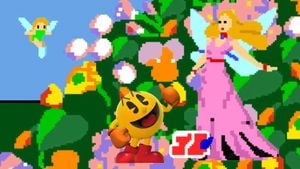Pac-Land: Difference between revisions
(→Layout) |
|||
| Line 27: | Line 27: | ||
Pac-Land Rosalina.jpg|{{SSB4|Rosalina}} next to the Fairy Queen. | Pac-Land Rosalina.jpg|{{SSB4|Rosalina}} next to the Fairy Queen. | ||
File:PacLandArcade.png|The town level as it originally appeared in ''Pac-Land''. A fire hydrant can also be seen. | File:PacLandArcade.png|The town level as it originally appeared in ''Pac-Land''. A fire hydrant can also be seen. | ||
File:Pac-LandΩ.jpg| | File:Pac-LandΩ.jpg|[[Ω]] form | ||
</gallery> | </gallery> | ||
Revision as of 18:31, November 6, 2014
| Pac-Land | |
|---|---|
 File:PacManSymbol.png Pac-Man on the stage. | |
| Universe | Pac-Man |
| Appears in | SSB4 (Wii U) |
| Availability | Unlockable |
| Article on Wikipedia | Pac-Land |
Pac-Land (パックランド, Pakkurando) is a stage that appears in Super Smash Bros. for Wii U.
Layout
Similar to Mushroomy Kingdom from Brawl and 3D Land from the 3DS version, it is a side scrolling stage. At least four locations from the game will appear, which are the town level, the bridge level, the mountain level, and the fairy world (which was just a goal in the original game). It is unknown if or what other locations from the game appear. The town section features fire hydrants, which could push players back in the original game, though it is not clear whether they have the same effect in this stage. The bridge area includes geysers that can move up and launch players into the air, while the mountain level serves as the Omega version of this stage.
Origin
The stage is based off of the arcade game, Pac-Land. The game was a side-scroller where one would go through three levels to bring a fairy to its home and then go through a level incorporating elements of the last three in the opposite direction to get home. The game is notable for being one of the first to use parallax scrolling (where the foreground and background move at different speeds to simulate perspective), long before it became a gaming mainstay in the 16 bit era, and also the first game to feature the more anthropomorphic design of Pac-Man in-game. Interestingly, the version published by Midway in the United States featured the character designs from the Hanna-Barbera Pac-Man cartoon. Pac-Land was later used in future Pac-Man games, yet with different designs. Its most notable modern appearance is in the second installment of the Pac-Man World trilogy being Pac-Man World 2.
Gallery
Pac-Man, Toon Link, Yoshi, and Male Wii Fit Trainer in Fairy Land.
Rosalina next to the Fairy Queen.
- Pac-LandΩ.jpg
Ω form
|
| |
|---|---|
| Fighter | Pac-Man (SSB4 · SSBU) |
| Assist Trophy | Ghosts |
| Stages | Pac-Maze · Pac-Land |
| Trophies and Spirits | Trophies · Spirits |
| Music | SSB4 · Ultimate |
| Masterpiece | Pac-Man |




